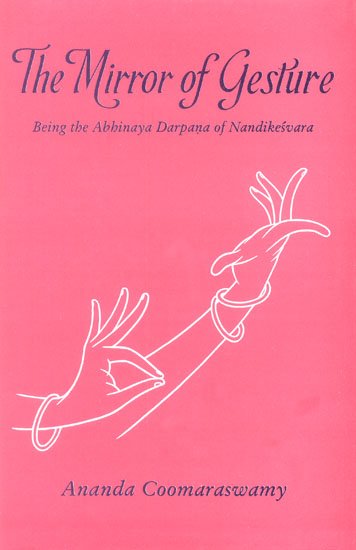Abhinaya-darpana (English)
by Ananda Coomaraswamy | 1917 | 16,981 words | ISBN-13: 9788121500210
The English translation of the Abhinaya-darpana (“the mirror of gesture”) by Nandikeshvara: an encyclopedic manual of the art of gesticulation. It belongs to a wide range of literature known as Natya-shastra: the ancient Indian art of dramatic performance, theatrics, dance and music. The Abhinaya Darpana is an abridgement of the Bharatarnava, a m...
Chapter 13 - Twenty-four Combined Hands
Combined Hands (samyutta hastāni):
Twenty-four combined Hands are exhibited as follows:
- Añjali,
- Kapota,
- Karkaṭa,
- Svastika,
- Ḍola,
- Puṣpapuṭa,
- Utsaṅga,
- Śivaliṅga,
- Kaṭaka-vardhana,
- Kartarī-svastika,
- Śakaṭa,
- Śaṅkha,
- Cakra,
- Sampuṭa,
- Pāśa,
- Kīlaka,
- Matsya,
- Kūrma,
- Varāha,
- Garuḍa,
- Nāga-bandha,
- Khaṭvā,
- Bheruṇḍa,
- Avahittha.
According to another book: when two Single Hands are combined, that is a Combined Hand. Even though the origin and meaning remain the same, the patron deity always differs.
Añjali (salutation): two Patāka hands are joined palm to palm. Usage: saluting Deities, Elders (guru) or Brāhmaṇas—the hands being held on the head for Deities, before the face for Elders, and on the chest for Brāhmaṇas.
According to another text: same definition. The patron deity is Kṣetrapāla. Usage: bowing, obedience, clapping time, indicating the form of Siva, saying “What am I to do?”, meditation. (Plate VIII.)
Kapota (dove): the hands are joined at the side, base and top. Usage: taking oath, conversation with elders etc., humble acquiescence.
According to another book: the Añjali hands are separated. The patron deity is Citrasena. Usage: acquiescence, trees such as the coconut, areca-nut, etc., plantain flower, cold, nectar, receiving things, casket, citron.
Karkaṭa (crab): the fingers of the hands are interlocked, and the hands turned inwards or outwards.[1] Usage: group, stoutness, blowing the conch, stretching the limbs, bending the bough of a tree.
According to another book: in the Urṇa-nābha hand, the fingers of one hand are introduced into the interspaces of those of the other hand. Its patron deity is Viṣṇu. Usage: lamentation, yawning, breathing hard, crab, blowing the conch, cracking the fingers by women. (Plates IV a, extreme left, and XII e.)
Svastika (crossed): two Patāka hands held together at the wrists. Usage: crocodile, timid speech, dispute, praising.
Dola (swing)[2]: two Patāka hands placed on the thighs. Usage: beginning a Nāṭya.
According to another book: Patāka hands at the sides. The patron deity is Bharatī. Usage: infatuation, fainting, drunken indolence, welcoming the beloved (vilāsa), etc.
Puṣpapuṭa (flower-casket): Sarpa-śīrṣa hands are pressed together. Usage: offering lights (ārati), twilight water offering (sandhya argha dāna), flower-spells (mantra-puṣpa), children receiving fruits, etc.
According to another book: one Sarpa-śīrṣa hand by the side of the other. The patron deity is Kinnareśvara. Usage: offering and receiving flowers, com, fruits, or water.
Utsaṅga (embrace): Mṛga-śīrṣa hands held upon opposite arm-pits. Usage: embrace, modesty, armlet, education of children.
According to another book: Arāla hands held crosswise on the shoulders. The patron deity is Gautama. Usage: modesty, embrace, assent, cold, saying “Sādhu”, hiding the breasts, etc.
Śiva-liṅga (do.): Ardha-candra with the left hand, Śikhara with the right. Usage: Śiva-liṅga.
Kaṭaka-vardhana (link of increase): Kaṭaka-mukha hands with crossed wrists. Usage: coronation, ritual (pūja), marriage blessing.
According to another book: Kaṭaka hands are crossed. The patron deity is Yakṣa-rāja. Usage: deliberation (vicāra), the erotic flavour (śṛṅgara rasa), pacification, (the dances known as) Jakkiṇī naṭana and Daṇḍa lāsya, certainty.
Kartarī-svastika (crossed arrow-shafts): Kartarī-mukha hands are crossed. Usage: trees, the boughs of trees, the summit of a hill.
Śakaṭa (car): Bhramara hands with the thumb and middle finger extended. Usage: the gestures of Rākṣasas.
Śaṅkha (conch): the thumbs of Śikhara hands are joined, and the forefinger extended. Usage: conch.
Cakra (discus): Ardha-candra hands askew, the palms in contact. Usage: discus.
Sampuṭa (casket): the fingers of the Cakra hand are bent. Usage: concealing things, casket.
Pāśa (noose): the forefingers of the Sūci hand are bent and interlocked. Usage: enmity, noose, manacles. (Plate XII f.)
Kīlaka (bond): the little fingers of the Mṛga-śīrṣa hand are interlocked. Usage: affection, the conversation of lovers.
Matsya (fish): Patāka hands face downwards, the thumbs and little fingers extended.[3] Usage: fish. (Plate XIV c.)
Kūrma (tortoise): the ends of the fingers of the Cakra hand are bent, except the thumbs and little fingers. Usage: tortoise. (Plate XIV D.)
Varāha (boar): Mṛga-śīrṣa hands one upon the other (back to back), the thumbs and little fingers linked. Usage: boar.
Garuḍa: Ardha-candra hands arè held with palms askew, and the thumbs interlocked. Usage: Garuḍa. (Plate XIV E.)
Nāga-bandha (serpent-tie): Sarpa-śīrṣa hands are crossed. Usage: nāga-bandha, pairs of snakes, bower, Atharva Veda spells.
Khaṭvā (bed): the thumbs and forefingers of two Catura hands are left free. Usage: bed, etc. (Cf. Plate XIV b).
Bheruṇḍa: the wrists of Kapittha hands are joined. Usage: pair of Bheruṇḍas.
Avahittha (dissimulation): two Alapadma hands are held on the chest. Usage: erotic dances (sṛṅgāra naṭana), holding a play-ball, the breasts (Plates XI e, XIII d).
Such are the twenty-four Combined Hands in order.
Footnotes and references:
[1]:
i. e. ‘clasped hands but the hands may also be flattened by extending the elbows, the fingers remaining interlocked, and this is used in stretching the arms over the head, a sign of amorous feeling frequently mentioned in literature and depicted in painting and sculpture (Plate IV A, extreme left).
[2]:
Apparently identical with the Kaṭyavalambita hand of T. A. Gopinatha Rao, “Hindu Iconography,” Vol. I, pt. i, p. 16, and ibid., Pl. V, fig. 11.
[3]:
The palm of one hand on the back of the other, the fingers along the fingers, and the two little fingers and thumbs moved to and fro.
